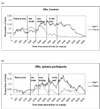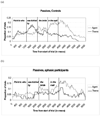Automatic processing of wh- and NP-movement in agrammatic aphasia: Evidence from eyetracking
- PMID: 20161014
- PMCID: PMC2748948
- DOI: 10.1016/j.jneuroling.2009.06.004
Automatic processing of wh- and NP-movement in agrammatic aphasia: Evidence from eyetracking
Abstract
Individuals with agrammatic Broca's aphasia show deficits in comprehension of non-canonical wh-movement and NP-movement sentences. Previous work using eyetracking has found that agrammatic and unimpaired listeners show very similar patterns of automatic processing for wh-movement sentences. The current study attempts to replicate this finding for sentences with wh-movement (in object relatives in the current study) and to extend it to sentences with NP movement (passives). For wh-movement sentences, aphasic and control participants' eye-movements differed most dramatically in late regions of the sentence and post-offset, with aphasic participants exhibiting lingering attention to a salient but grammatically impermissible competitor. The eye-movement differences between correct and incorrect trials for wh-movement sentences were similar, with incorrect trials also exhibiting competition from an impermissible interpretation late in the sentence. Furthermore, the two groups exhibited similar eye-movement patterns in response to passive NP-movement sentences, but showed little evidence of gap-filling for passives. The results suggest that aphasic and unimpaired individuals may generate similar representations during comprehension, but that aphasics are highly vulnerable to interference from alternative interpretations (Ferreira, 2003).
Figures







References
-
- Allopenna PD, Magnuson JS, Tanenhaus MK. Tracking the time course of spoken word recognition using eye-movements: Evidence for continuous activation models. Journal of Memory and Language. 1998;38:419–439.
-
- Arnold JE, Eisenband JG, Brown-Schmidt S, Trueswell JC. The rapid use of gender information: Evidence of the time course for pronoun resolution from eyetracking. Cognition. 2000;76(1):B13–B26. - PubMed
-
- Avrutin S. Weak Syntax. In: Grodzinsky Y, Amunts K, editors. Broca's region. New York, NY: Oxford University Press; 2006. pp. 49–62.
-
- Bever T. The cognitive basis for linguistic structures. In: Hayes JR, editor. Cognition and the development of language. New York: Wiley; 1970. pp. 279–362.
-
- Bever TG, McElree B. Empty categories access their antecedent during comprehension. Linguistic Inquiry. 1988;19:35–43.
Grants and funding
LinkOut - more resources
Full Text Sources
Miscellaneous
